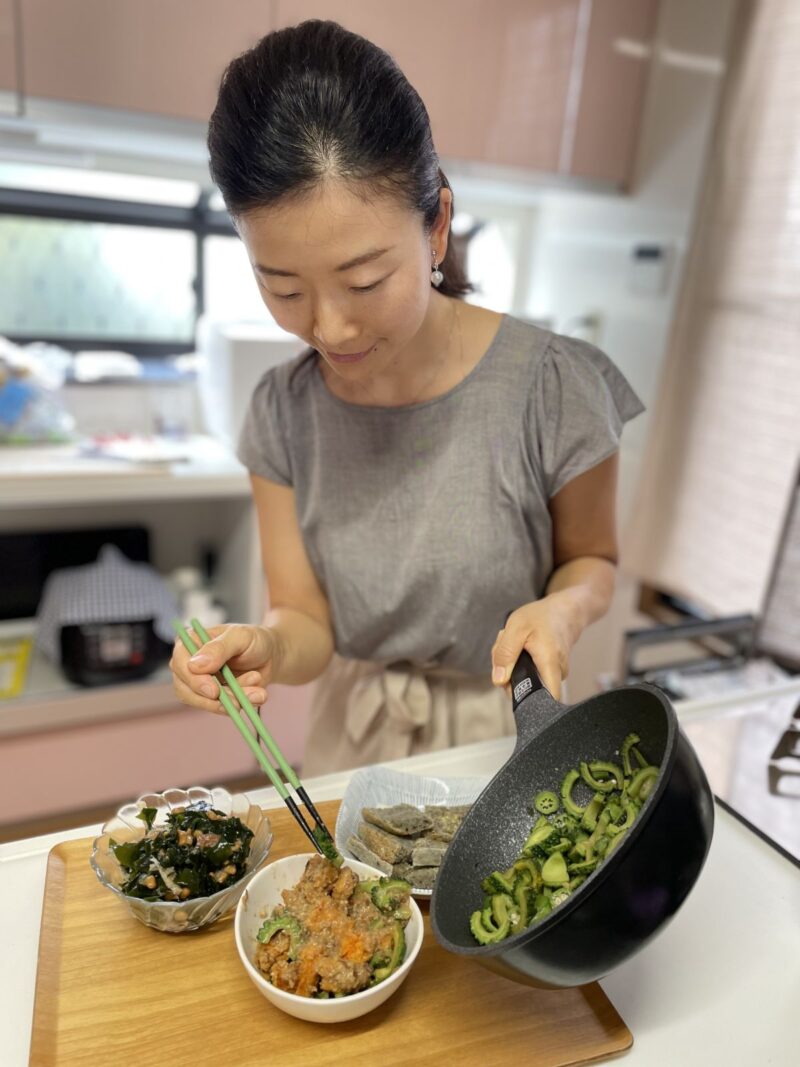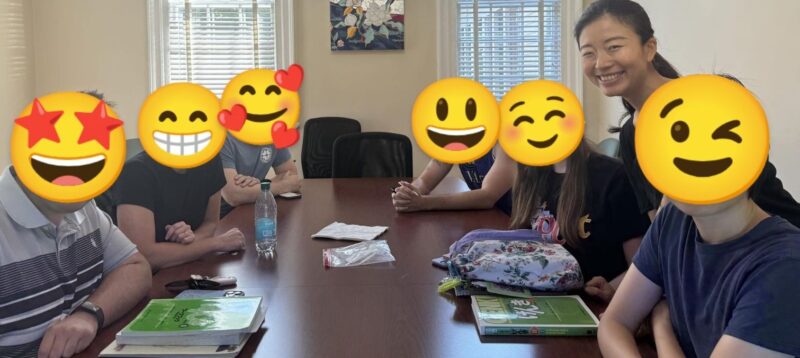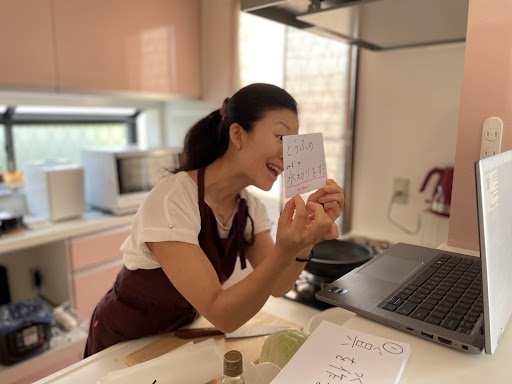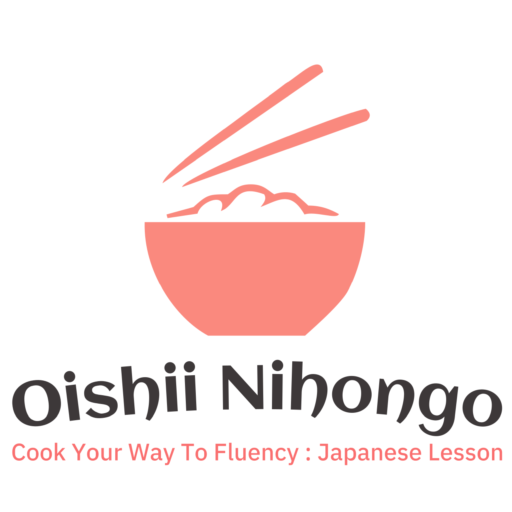Thank you for visiting Oishii Nihongo.
I’m Maiko, a registered dietitian in Japan and Japanese language teacher.
If you want to read in Japanese, please click here.




What Oishii Nihongo can do for you
On this site, with my 14 years of experience as a dietitian and 5 years as a Japanese teacher, I’ve prepared the following to make learning Japanese through cooking fun for you, and to help you lead a healthier life that’s also good for the earth environment:
- Recipes specially designed for learning Japanese, complete with vocabulary lists, grammar explanations, and quizzes.
- Cooking classes conducted in Japanese for practicing the language.
- Cooking classes on Japanese cuisine conducted in English for those who just want to know how to cook Japanese healthy authentic foods.
- Simple and healthy Japanese recipes, along with suggested meal plans that balance nutrition.
- Articles in Japanese about basic nutrition knowledge for a healthy body.
- Articles in Japanese on the wonderful impact a plant-based diet can have on the environment.
- Recommendations for essential ingredients when making Japanese cuisine, where to buy them, and useful gadgets and services.
Although this blog is still developing, I’m steadily accumulating information that can be of help to you.
For those who want to learn healthy Japanese cooking and study Japanese through cooking, this is the best lesson.
Our site is especially great for those who want to “try making healthy Japanese cuisine and study Japanese through cooking.” Do you have any of these concerns?
- Wanting to try making Japanese cuisine but not knowing how to combine seasonings or use ingredients.
- Wanting to know recipes for delicious Japanese dishes that don’t use meat, fish, eggs, or dairy products.
- Wanting to study Japanese through cooking and be able to use vocabulary and grammar.
- Wanting to use Japanese in the future to conduct cooking classes of your own country.
Why I transitioned to a Plant-based diet
It took me about 9 months to fully transition to a plant-based diet. After moving to America, because of my family’s preferences, I started eating less natto and tofu and more chicken, eggs, ham, cheese, and other dairy products and meats, which lead me feeling tired, sleepy, and sluggish. I decided to cut out dairy products in December 2021 because I thought eating too much cheese might be the problem.
After that, I was still eating chicken, eggs, shrimp, and salmon. The turning point to switch to a plant-based diet came in September 2022. I suffered from terrible menstrual pain like never before, lying in bed with excruciating pain all day without moving. At that moment, I remembered hearing that “hormones in meat can affect human hormone balance.”
This was a phrase I often heard in a podcast by the Physicians Committee, which presents reliable research results on how a plant-based diet affects the human body, spoken by American doctors and dietitians. According to that episode, dairy and meat can cause inflammation in the human body, leading to various health problems, and consuming hormones used for mass-producing meat can negatively affect human hormone balance.
After that terrible menstrual pain, I started a plant-based diet. As a result, I feel much better now, clearly less tired than before. Most importantly, my menstrual pain has become much lighter. I used to dread the monthly arrival of my period, but now I’m really glad I switched to a plant-based diet.
Also, since switching to a plant-based diet, my skin condition and gut health have improved significantly. Through my experience, I want you to try a plant-based diet and see what changes it brings to your body.
When did Veganism spread in Japan?
There is a type of Japanese cuisine called Shojin ryori. Originally eaten by Buddhist monks around the 9th century, it spread to the general public around the 13th century with the spread of Zen Buddhism. Shojin ryori avoids all animal-based foods and also strong-smelling foods like garlic, leeks, and green onions.
The Japanese cuisine eaten at home today retains influences from Shojin ryori. For example, the use of soybean products in many dishes and dashi broth made from kelp and shiitake mushrooms are old techniques for making delicious food without meat that are still used today. In this website and cooking lesson, I introduces not only common Japanese restaurant dishes but also delicious and healthy Japanese home cooking that every Japanese person knows.
Maiko’s Career as a Registered dietitian
- Working at a diabetes specialized clinic in Japan from 2011 to 2020
- Daily nutritional counseling for 10-15 people with various lifestyle-related diseases such as diabetes, hyperlipidemia, and hypertension,
- Acquired the qualification of Diabetes Care and Education Specialist, and worked in a clinic with a great atmosphere and ambitious staff, allowing me to grow a lot as a dietitian.
- Currently providing online nutrition counseling to 3-4 people who needs a primary care per day.
I am now involved in primary prevention for people who are not yet sick. I specialize in making knowledge about disease prevention and diet easy to understand and tailored to each individual’s lifestyle and preferences.
With 13 years of experience as a dietitian and over 10,000 nutritional consultations, I’m full of insights on maintaining health.
Maiko’s Career as a Japanese Teacher
- Completed 420 hours of Japanese language training in 2018 and passed the Japanese Language Teaching Competency Test.
- Attended Human Academy while working as a dietitian and obtained the official qualification to work as a Japanese teacher.
- Started private Japanese lessons after moving to America in February 2020,
- Working as a professional Japanese teacher on Italki, with over 200 students, more than 3000 lessons, and a 5-star rating as of June 2024.
- Began working at the Japan Center at North Carolina State University in January 2021.
- Teaching mainly beginner group lessons at the Japan Center, a facility of the state university, using the Genki textbook. I understand where beginners tend to stumble, so I teach points to be careful about in advance and provide fun and easy ways to study.
Oishii Nihongo’s Mission
- To make studying Japanese through our cooking classes fun, efficient, and practical.
- To deepen understanding of Japanese culture and communication with Japanese people through my cooking classes.
- To increase the number of people who are healthy and energetic with a plant-based diet.
- To protect the beautiful environment of the earth with an eco-friendly way of eating.
- To increase the number of people who maintain a healthy body and can do what they love at any age.
- To increase the number of people who are less likely to get sick or who recover quickly if they do.
Maiko’s Profile
- 36 years old, born in Fukuoka City, Fukuoka Prefecture, currently live in North Carolina, USA.
- Worked in nutritional guidance at a diabetes specialty clinic for 9 years before moving to America, and now works online providing specific health guidance to Japanese people and as a Japanese teacher,
- Hobbies: Cooking, hiking, rock climbing, snorkeling, traveling, baking, singing, studying English and Spanish.
- Life goal: To spread the goodness of Japanese food around the world. Japanese food is basically low in oil and rich in vegetables. Traditional home cooking is not well known, so I want to connect the world and Japan through Japanese cooking classes. Also, one of my dreams is to hike, rock climb, ski in mountains around the world, snorkel in seas around the world, eat delicious food in towns around the world, see beautiful historical buildings, and interact with people from all over the world. In the future, I want to travel around the world and open a vegan cafe and cooking school, as well as a Japanese language school.
Thank you for reading!!
If you are even a little interested in Japanese lessons, please contact me. Let’s plan a lesson together!
I look forward to see you in lessons!

